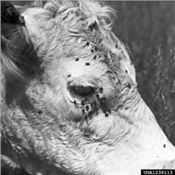Flies And Pink Eye A Problem Again This Summer
DR. RIC BESSIN AND DR. JONATHAN L. LARSON
LEXINGTON, KEN.
Face flies are annoying pests for cattle that can impact the animal’s welfare by just constantly molesting the eyes of our animals. These flies are looking to feed on tears but will also feed on saliva, blood, and nasal discharges. They do this by using their unique mouthparts, which resemble sponges and help them consume their liquid foods. Recently, county Extension agents informed us that they have received a large influx of questions regarding the connection between these pests and their transmission of pink eye.
Identification & Life cycle
Face flies look very similar to house flies in shape and coloration but are slightly larger than their close relative. They are dark grey with four black stripes that run down their back. As with a lot of flies, the maggots develop in fecal material. Specifically, face fly maggots develop in freshly deposited cattle manure. The maggots will hatch from eggs and then go through four stages of development over 15 to 25 days, depending on the weather. During the summer, face flies are not often found in structures, but the adults do overwinter in barns or attics and will become active again in the spring to start the next generation of flies.
Pink Eye Transmission
High numbers of face flies are associated with higher rates of pink eye issues. The feeding style of the flies causes more avenues of introduction by scratching the eyes, and the flies have been demonstrated to carry the causative agent of pink eye as well. Some estimates put the cost of pink eye in cattle at about $150 million annually.
Management Must Be Multifaceted
Fly control is essential, but can be difficult as face flies are only on the animal for a small percentage of the time. Therefore, addressing the egg and larval stages of the fly, as well as the adults, is most effective. A moderate to heavy fly infestation is when there are 10 to 20 flies per animal during the middle of the day. A single fly-control program will not work on every farm, so it often takes multiple tactics of control to achieve good results.
Fly tags (mid- to late May, through mid-September-October)(one ear tag or session or two sessions; be sure to use the number of tags required by the manufacturer), insecticide pour-ons, back rubbers (no 2 diesel), dust bags and knock-down sprays (Bachpack or ATV) are helpful in reducing the number of adult face flies on your animals. Fly traps in barns can also be helpful in reducing the number of flies. Feed additives with insect growth regulators are available that target the maggots that are laid in the manure. Encouraging dung beetles, which break down the manure pat, will also decrease egg survival.
Face flies can develop resistance to pesticides over time, so switching the drug mode of action of pesticides used every year is important. For example, if pyrethrins are used one year, then organophosphates should be used the following year. Waiting until the start of fly season to apply fly tags and removing the old fly tags in the fall also decreases the development of resistance. It is also extremely important to follow the safety precautions recommended by the manufacturer, as these insecticides can be toxic to people if handled improperly.
Appropriate grazing, along with clipping pastures will prevent seed-head development, reducing the irritation to the eyes of cattle, as well as reducing the resting areas for the flies. Clipping pastures to a low stubble height in May just after the seed heads emerge and again in mid-summer when weeds appear is recommended. Shaded areas need to be available to decrease the ultraviolet (UV) exposure and, in Herefords, breeding for pigmented eyelids has been successful, as this is a heritable trait. A good management program, including an appropriate vaccination program [especially infectious bovine rhinotracheitis (IBR) and bovine viral diarrhea (BVD)] and having good quality nutrition and minerals available at all times, will improve the overall condition of the cattle and decrease the incidence of this disease. Overhead hay feeders should be lowered and round bales should be rolled out. Ensuring adequate bunk space will decrease direct contact between the animals. Animals that develop pinkeye should be isolated if possible. ∆
DR. RIC BESSIN: Entomology Extension Specialist, University of Kentucky
DR. JONATHAN L. LARSON: Entomology Extension Specialist, University of Kentucky

Figure 1: Face flies are in the same genus as house flies and look very similar to that species. They are slightly larger in comparison and are less common
in structures in the summer. Adults can be found resting on plants and fences when not on animals.
Photo: Whitney Cranshaw, Colorado State University, Bugwood.org

Figure 2: Face flies feed on tears they induce from the eyes of cattle. The feeding style of the flies leads to irritation and can open the eyes up to infection by pathogens, in particular pink eye.
Photo: Clemson University – USDA Cooperative Extension Slide Series, Bugwood.org